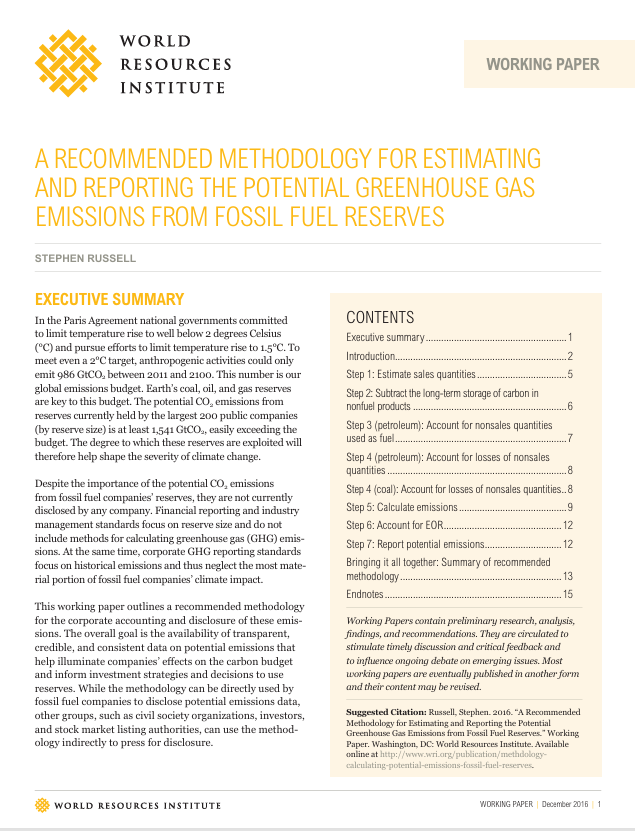
A recommended methodology for estimating and reporting the potential greenhouse gas emissions from fossil fuel reserves
This working paper presents a methodology for fossil fuel companies to estimate and disclose potential greenhouse gas emissions from their reserves. It outlines seven steps for calculating emissions, addressing combustion, leakage, and storage factors, with the aim of improving transparency and enabling comparison across companies and alignment with climate targets.
Please login or join for free to read more.

OVERVIEW
A recommended methodology for estimating and reporting the potential greenhouse gas emissions from fossil fuel reserves
Introduction
Potential emissions refer to the future release of carbon (CO₂ and CH₄) currently stored in fossil fuel reserves. These emissions are central to discussions on the global carbon budget, which limits emissions to maintain a likely chance of capping temperature rise at 1.5°C or 2°C. As of 2011, only 986 GtCO₂ of the 2,900 GtCO₂ budget remained.
Reserves held by the 200 largest public fossil fuel companies total 1,541 GtCO₂—156% of the remaining budget. To meet climate targets, at least one-third of oil, half of gas, and over 80% of coal reserves must remain unexploited through 2050. This may result in “stranded assets,” affecting company valuations and market stability.
The nature and importance of potential emissions
Reserves are being used and replaced quickly, likely surpassing allowable emissions. Existing assessments often ignore upstream emissions such as flaring, fugitive releases, and energy use, which can comprise up to 37% of life-cycle emissions.
Scope and objectives of paper
The methodology targets company-level reserves and aims to estimate emissions released during and after production. It excludes emissions not tied to stored carbon and does not provide a full stranded asset risk analysis.
Objectives include:
- Improving emissions transparency
- Highlighting operational emissions sources
- Supporting risk assessment
- Enabling cross-company comparisons
Development Process
The methodology was developed via research and feedback from regulators, auditors, NGOs, and companies.
Outline Of Methodology
Seven steps are proposed:
- Estimate sales quantities
- Subtract carbon in long-lived nonfuel products
- Account for internal fuel use
- Account for nonsales losses
- Calculate emissions
- Account for CO₂ stored via EOR
Report emissions
Step 1: Estimate Sales Quantities Of Fossil Fuels
Use PRMS for oil and gas, and the CRIRSCO template for coal. Exclude royalties and reflect current contractual terms.
Step 2: Subtract Long-Term Storage Of Carbon In Nonfuel Products
Storage varies. Oil retains 5–10% of carbon, compared to <2% for gas and coal. Companies may use published storage factors or conservative assumptions.
Step 3: Account For Nonsales Quantities Used Internally As Fuel
Include lease fuels used on-site. Attribute emissions proportionally to ownership share.
Step 4: Account For Losses Of Nonsales Quantities From Flaring, Venting, And Fugitive Sources
These losses can significantly impact emissions. CH₄ leakage may equal 12% of combustion emissions. Downstream losses may be included if not double counted.
Step 5: Calculate Emissions From Fossil Fuel Combustion And Leakage
Use field-specific or default emission factors. Apply an oxidation factor of 1.0 and flaring destruction factor of 0.98. Use a CH₄ GWP of 28.
Step 6: Account For CO₂ Enhanced Oil Recovery (EOR), If Relevant
Include CO₂ EOR only if the CO₂ is from the company’s own fossil fuel production, using a fixed rate of 0.3 tonnes per barrel. Exclude CCS projects.
Step 7: Report Potential Emissions
Report separately for proved and probable reserves, by gas type and in CO₂e. Disclose assumptions, sources, and any exclusions. Emissions should be reported outside inventory scopes.
Bringing It All Together
Extracting current reserves would exceed the remaining carbon budget. Standardised, transparent emissions reporting is essential for informed decision-making and alignment with global climate targets.


